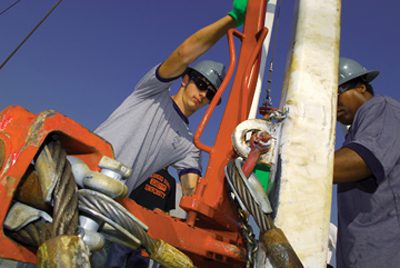"No economic development phenomenon of this magnitude could be successful without the educational workforce component. The role of ASU-Searcy is absolutely vital to the overall success of this industry in Central Arkansas."
– Danny Games
Chesapeake Energy Corporation  By Sonja J. Keith
By Sonja J. Keith
The natural gas rig located on the back side of the campus at ASU-Searcy may not actually be in production, in fact it is just a simulator, but the potential it represents for students and their futures is priceless.
The equipment is a key component in the Floorhand Training Program, a non-credit, 40-hour, one-week course at Arkansas State University-Searcy. The program provides students with occupational training skills and on-the-job experience with a simulator, as well as essential classroom training.
Robert Watkins is the director of gas drilling programs at the Searcy campus and the floorhand training instructor.
Each class includes training in both a classroom environment and on a realistic drilling rig simulator that has been erected on the campus. The curriculum focuses on intensive training in drilling operations and Occupational Safety & Health Administration (OSHA) safe working procedures. Upon completion of the program, students receive a Forklift Operator’s certification, Rig Pass, Basic CPR and First Aid, and a Floorhand completion certificate. These credentials are recognized by the International Association of Drilling Contractors (IADC).
With a $75,000 donation from each Chesapeake Energy Corporation and Nomac, and a $50,000 donation from Union Drilling, the program started accepting students in April. High Plains Technology donated the training through the end of June, and ASU-Searcy received a $280,000 grant to continue the program.
As of July 11, 88 students have completed the training and over half are already working in the industry. Students are employed by companies such as Union Drilling, Premier Well, Nomac, Helmick & Paine, and Saxton, with an average hourly wage of $14 to $22.50.
Natural gas companies are referring applicants to the class and word about the course is spreading. There is a six- to seven-week waiting list to get in. “I have 140 applications on my desk and more coming every day,” Watkins said.
About 80 percent of those who have participated in the class are from the Searcy area, but the class has attracted students from as far away as Marshall. “Some don’t mind driving two hours a day to get here,” Watkins said. About 35 percent of those who complete the course go to work for a gas company or related business in the first month or so.
Matthew Merritt of Rose Bud was among the students recently enrolled in the program. He considers the class a valuable experience – one that he plans to put to work in the field. “It gives you a good look at what you’re going to be up against,” he said.
The program includes two days of classroom instruction before students don hard hats and green gloves to work on the rig simulator, trying their hand executing the information they have been given.
“You bring it all together once you get out here,” Merritt said.
“The most important thing is out here (on the simulator),” Watkins said of the course.
Watkins admits that those in the gas industry speak a different language, and he introduces students to the terminology. For example, those who work on a rig are called “rough necks.”
“By lunch today we’ll be tripping pipe (placing pipe in the ground or pulling it out),” he said. “We’re learning how to make connections.”
Safety, how to keep a rig clean and teamwork are also important skills that are covered, according to Watkins. “When they hit the rig, they have a head start compared to someone off the street.”
Students are also taught the importance of showing up for work and being on time. Watkins said it is important to understand the “3 No’s” in the industry – “no show, no call, no job.”
Don Harlan, vice chancellor for ASU-Searcy, said the school is working with natural gas companies and related service firms to create training opportunities for new as well as existing employees. “We are offering what the industry wants right now,” added Dottie Whiteside, director of the economic development center at ASU-Searcy.
School officials plan to expand facilities and programs to meet the workforce needs expressed by the petroleum industry. In fact, 4,000 square feet of space on campus is being renovated or constructed. “Some space, we envision, will serve the petroleum industry,” Harlan said. “We’re looking at what programs they want us to provide that will train their employees or future employees.”
Both Harlan and Whiteside noted that the natural gas industry has provided a lot of jobs for residents in the Searcy area, which was welcome news after Whirlpool closed a plant in December 2006, displacing 700 employees. “It has provided an opportunity for a lot of people in Searcy,” Harlan said. “If it hadn’t been for the Fayetteville shale, a lot would have been in dire straits.”
Whiteside added that one ASU-Searcy student went to work at a gas company for $15 an hour after completing the program and within a week had been bumped up to $22.50 an hour “because of what he knew.” She said while other communities might be struggling because of the national economy, Searcy is “booming.”
Merritt hopes to join the ranks of those working for a natural gas company. “My dad was in the oil business. I think it is something I should get into because of where it’s going. It will be here for a long time. And the money. It’s all about the money.”
Watkins has been involved in the gas industry for 30 years and has had some unique jobs – “from New York to nearly Mexico.” This is the third gas boom for him to work. “This one is still young but it’s still growing,” he said. “This is a fun job. I really enjoy what I’m doing.”

